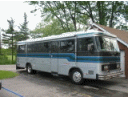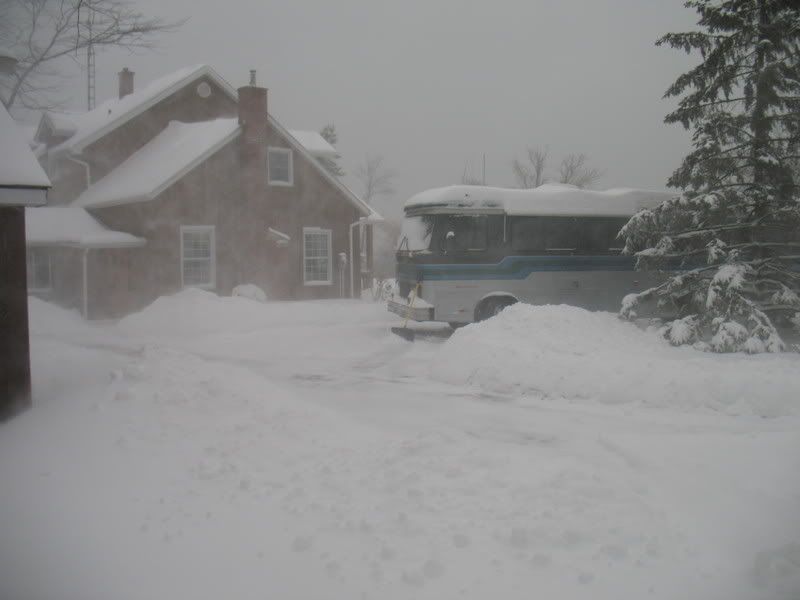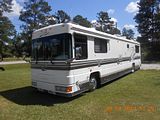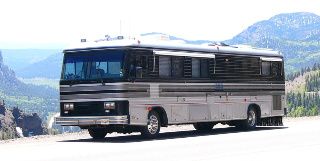Page 1 2
Go to...  | Start A New Topic  | Search  | Notify  | Tools  | Reply To This Topic  |  |
 6/17 6/17 |
I've heard folks talk about putting their coaches on blocks for the winter to protect the tires. Is this worth the effort? Richard R.P.Muise 1994 Breakaway/Cummins 5.9/Allison transmission/Spartan Chassis | ||
|
Surely you're going to fire it up every 30 days and either drive it or let the engine run until it warms up? If so, and you have airbags, it will raise the coach so I would remove the blocks whenever the engine is running. The transmission (driveshaft) seal will probably dry, shrink, and then leak if you don't exercise the transmission for 3-6 months, so I strongly recommend at least a driveway jaunt once a month. I put the jacks down to relieve the strain and put wooden sheets under the tires. "You are what you drive" - Clint Eastwood | ||||
|
| The Old Man and No Barth |
Gunner's advice is good. Using the jacks relieves tire sidewall stress from standing in one spot. Exercising the whole coach monthly reduces the likelihood of seals drying out, prevents rust from forming in mechanical components as lubricants drain away, keeps everything that rotates running free, & flexes the tire rubber. Parking with the the tires on wood instead of the ground, concrete, or pavement is a good idea. Most of us use don't use our coaches enough to wear out the tires before the end of their recommended lifespan, & anything we can do to slow down deterioration from weathering seems wise. | |||
|
I couldn't agree more! I bring the Stagecoach out of storage and take it to work every three weeks and I bring it to the house once a month for the weekend. Between the two trips a month, I keep it from sitting too long. | ||||
|
 |
Sometimes it is difficult to get out of the driveway!  1990 Regency 34' Cummins 6CTA 8.3 240hp Spartan Chassis, 4 speed Allison MT643 | |||
|
 |
Best advertisement I have seen for the southern Barth owners so far. Nick | |||
|
Is that white stuff due to global something? | ||||
|
...About that snow shovel leaning against the bumper.....Like the old saying goes: Tie it to the front end and head south.....When a local points to it and says, "What's that?", you'll know you have arrived | ||||
|
This is the beginning of being called a "Halfback" I lived up north and got snowed in too many times. Retired way down south in the bottom of Florida. Now I'm "Half" way "Back" in Tennessee......... Former owner of "THE TOY" 1988 Barth Regal SE 33' Tag 1992 Barth Breakaway 32' 2005 Coachmen Mirada 32' DS | ||||
|
You southern folk don't know what snow and cold air is. That's when its time to load those oak logs into the fireplace and sit back and enjoy a good book and your favorite drink. There's nothing like the sight of fresh fallen snow covering the trees. And you don't see pictures of Santa Claus trying to make his way through the swamps of Georgia and Florida, now do ya? He knows where its good to be. | ||||
|
| First Month Member |
Seems like I read a similar story about a guy and an anchor.............. But, back on subject, I agree on taking the load off the same spot on the sidewalls. Here is what Goodyear has to say: Ideally, a vehicle in storage should be placed on blocks to remove all weight from the tires. If the vehicle cannot be put on blocks, follow these steps for tire protection: • Completely unload the vehicle so that minimum weight will be placed on the tires • Inflate tires to recommended operating pressure plus 25%. Ensure that the rim manufacturer’s inflation capacity is not exceeded • Be sure the storage surface is firm, clean, well drained and reasonably level • Avoid moving the vehicle during extremely cold weather • Move the vehicle at least every three months to prevent ozone cracking in the tire bulge area, as well as “flat-spotting” from the prolonged strain of sidewall and tread deflection • Adjust inflation before putting the vehicle back into service http://www.goodyear.com/rv/pdf/rvbrochure.pdf ---------------------------------------------- I would try to take it for a drive when conditions allow. Just running it in the driveway seems not to be recommended by a number of manufacturers. I have seen recommendations of a 20 mile minimum, but it really depends on load and outside temp and how long the fluids are at operating temperature. I drive mine until the oil pressure drops all the way and then drive back. I know aircraft engines also need a prop load. Anything less is not recommended. . 84 30T PeeThirty-Something, 502 powered | |||
|
I am one that does NOT recommend running the engine periodically for short times during storage. I run many engines on a dyno for testing and during the winter months (I know winter in California--) you would be amazed how much condensation forms during a 3 hour dyno test. This would be where we do a run in to get everything kinda broken in and then do some reasonable pulls. I remember one particularly cold and wet winter we had built up 4 BMW V-12s stroking/sleeving them to get 6.0L and then running them in on the dyno before installing them into customer's cars. There was so much water inside the engines after the dyno runs, my dyno operator thought that we had missed a gasket or had cracked the block and coolant was getting into the crankcase. I showed the operator that we had purposely put dye into the coolant so that if any leaks developed we could find them, the water under the valve covers and around the timing chain areas was clear, he was relieved but it did prove the point of how much water (condensate) will form with brief running periods during cold days. The engine oil will never get over 180 to 200 degrees just idling and after a few runs, there are pools of condensate (water) in a lot of the areas that run just a bit cooler. At those temps, water will not evaporate quickly, take a long time. IMHO, don't run the engine until you have the ability to run it for at least an hour and at power (cruise speed) for at least 1/2 hour continuously. Make sure you have topped off your fuel tank, again to prevent condensation from forming, this is another major and often overlooked problem area. Everything else has been well covered. Ed 94 30' Breakaway #3864 30-BS-6B side entry New Cummins 5.9L, 375+ HP Allison 6 speed Spartan chassis K9DVC Tankless water heater | ||||
|
Captain Doom |
I'm with MWrench. Starting a diesel and letting it idle is NOT a good idea, even less so than a gaso engine. Except for testing, etc., start it, get moving right away, and run at least until the temp hits normal running range (NLT 10 miles). Rusty '94 28' Breakaway: MilSpec AMG 6.5L TD 230HP Nelson and Chester, not-spoiled Golden Retrievers Sometimes I think we're alone in the universe, and sometimes I think we're not. In either case the idea is quite staggering. - Arthur C. Clarke It was a woman who drove me to drink, and I've been searching thirty years to find her and thank her - W. C. Fields | |||
|
"Host" of Barthmobile.com 1/19 1/19 |
Right on Rusty and Ed. Idle will not do anything unless you get it under a load. That will require movement for 10 miles or more. Just warming it up, and not burning off the condensation is not the way to go.
| |||||||||||||||
| ||||||||||||||||
Just to make sure I'm okay with current practices, when I take it to work, it takes me about 40 minutes drive time plus time to warm up, build air pressure and a couple of minutes at destination. It sounds like the monthly trip to the house might be dropped since it only takes about 10 minutes plus warm-up. I don't do either of these scenarios when it is very cold. What say you? | ||||
|
| Powered by Social Strata | Page 1 2 |
| Please Wait. Your request is being processed... |
|
This website is dedicated to the Barth Custom Coach, their owners and those who admire this American made, quality crafted, motor coach.
We are committed to the history, preservation and restoration of the Barth Custom Coach.
We are committed to the history, preservation and restoration of the Barth Custom Coach.




